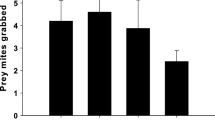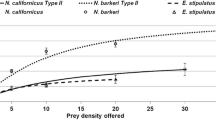Abstract
To find suitable candidates for biological control of the bulb mite, Rhizoglyphus robini Claparède (Acari: Astigmata) on lilies, exploration was undertaken in areas where the bulb mite is an established pest (The Netherlands, Taiwan and Japan). Among the predators, found in association with R. robini in the field and under storage conditions, mesostigmatic mites predominate. The most abundant species were Hypoaspis aculeifer (Canestrini), Lasioseius bispinosus Evans and Parasitus fimetorum (Berlese). These predators appeared to feed and reproduce on a diet of exclusively R. robini and they were able to control the bulb mite in small-scale population experiments initiated with a 1:20 predator-prey ratio. Under laboratory conditions corresponding to lily bulb propagation (lily scales mixed with vermiculite and stored at 23°C and >90% RH) the laelapid mite, H. aculeifer, was the most effective predator; the ascid predator, L. bispinosus, was much less effective, but being relatively small and being successful in attacking the juvenile stages of the bulb mite it may be better able to search for bulb mites hidden inside the lily bulb. The parasitid predator, P. fimetorum, failed to control the bulb mite when vermiculite was used as a medium, but turned out to suppress this prey when peat was used instead. Various strains of H. aculeifer or closely related species were compared with respect to their impact and performance on bulb mites as prey: two Dutch strains, one obtained from Breezand and the other from 'tZand, a Taiwanese strain, a German strain that in contrast to the previously mentioned strains was not collected from lily bulbs, but from agricultural areas near Bremen and, in addition, a Canadian strain of a related species (Hypoaspis miles Berlese), known to control sciarid fly larvae. These comparative experiments showed that H. miles died out without noticeable impact on the bulb mite population whereas all strains of H. aculeifer were able to suppress the bulb mites to very low numbers. However, the numerical responses of the H. aculeifer strains differed in that those collected in association with the pest (Breezand > Taiwan > 'tZand) were superior to the strain from Bremen. These results do not provide support to the Hokkanen and Pimentel hypothesis, which states that predators forming an evolutionary new association with the pest are often more effective in biological control.
Similar content being viewed by others
References
Barker, P.S. 1969. The response of a predator, Hypoaspis aculeifer (Canestrini) (Acarina, Laelapidae) to two species of prey. Can. J. Zool. 47: 343–345.
Chambers, R.J., Wright, E.M. and Lind, R.J. 1993. Biological control of glasshouse sciarid flies with the predatory mite, Hypoaspis miles, on cyclamen and poinsettia. Biocontrol Sci. Technol. 3: 285–293.
Gillespie, D.R. and Quiring, D.M.J. 1990. Biological control of fungus gnats, Bradysia spp. and western flower thrips, Frankliniella occidentalis, in glasshouses using a soil dwelling predatory mite, Geolaelaps sp. nr. aculeifer. Can. Entomol. 122: 975–983.
Glockemann, B. 1992. Biological control of Frankliniella occidentalis on ornamental plants using predatory mites. EPPO Bull. 22: 397–404.
Hoda, F.M., Taha, H.A., Ibrahim, G.A. and El-Beheri, M.M. 1986. Biological observations on the predatory mite Hypoaspis miles Berlese (Acarina: Laelapidae). Bull. Soc. Entomol. d'Egypte 66: 103–106.
Hokkanen, H.M.T. and Pimentel, D. 1984. New approach for selecting biological control agents. Can. Entomol. 116: 1109–1121.
Hokkanen, H.M.T. and Pimentel, D. 1989. New associations in biological control: theory and practice. Can. Entomol. 121: 829–840.
Inserra, R.N. and Davis, D.W. 1983. Hypoaspis nr. aculeifer: a mite predacious on root-knot and cyst nematodes. J. Nematol. 15: 324–325.
Kevan, D.K.McE. and Sharma, G.D. 1964. Observations on the biology of Hypoaspis aculeifer (Canestrini, 1884), apparently new to North-America (Acarina: Mesostigmata: Laelapidae). Acarologia 6: 647–658.
Lesna, I., Conijn, C.G.M. and Sabelis, M.W. 1995. Biological control of the bulb mite, Rhizoglyphus robini, by the predatory mite, Hypoaspis aculeifer, on lilies: predator-prey interactions at various spatial scales. J. Appl. Ecol. in press.
Lobbes, P. and Schotten, C. 1980. Capacities of increase of the soil mite Hypoaspis aculeifer Canestrini (Mesostigmata: Laelapidae). Zeitschrift für Angewandte Entomologie 90: 9–22.
Luck, R.F., Shepard, M.B. and Kenmore, P.E. 1988. Experimental methods for evaluating arthropod natural enemies. Ann. Rev. Entomol. 33: 367–391.
Murphy, P.W. and Sardar, M.A. 1990. Resource allocation and utilisation contrasts in Hypoaspis aculeifer (Can.) and Alliphis halleri (G. & R. Can.) (Mesostigmata) with emphasis on food source. In The Acari, reproduction, development and life-history strategies, R. Schuster and P.W. Murphy, (eds), pp. 301–312. Chapman & Hall, London.
Ragusa, S. and Zedan, M. 1988. Biology and predation of Hypoaspis aculiefer (Canestrini) (Parasitiformes, Dermanyssidae) on Rhizoglyphus echinopus (Fum. & Rob.) (Acariformes, Acaridae). Redia 71: 213–225.
Ragusa, S., Zedan, M.A. and Sciacchitano, M.A. 1986. The effects of food from plant and animal sources on the development and egg production of the predacious mite Hypoaspis aculeifer (Canestrini) (Parasitiformes, Dermanyssidae). Redia 69: 481–488.
Sardar, M.A. and Murphy, P.W. 1987. Feeding tests of grassland soil-inhabiting gamasine predators Acarologia 28: 117–121.
Shereef, G.M., Soliman, Z.R. and Afifi, A.M. 1981. Economic importance of the mite Hypoaspis miles (Mesostigmata: Laelapidae) and its life history. Zool. Soc. Egypt Bull. 30: 103–108.
Usher, M.B. and Davis, P.R. 1983. The biology of Hypoaspis aculeifer Canestrini (Mesostigmata): is there a tendency towards social behaviour? Acarologia 14: 243–250.
Waage, J.K. and Greathead, D.J. 1988. Biological control; challenges and opportunities. Phil. Trans. R. Soc. Lond. B 318: 111–126.
Zedan, M. A.-A. 1988. Studies on predator-prey interactions between Hypoaspis aculeifer Canestrini (Acarina: Laelapidae) and Rhizoglyphus echinopus (Fum. & Rob.) (Acarina: Acaridae) under laboratory conditions. J. African Zool. 102: 381–387.
Author information
Authors and Affiliations
Rights and permissions
About this article
Cite this article
Lesna, I., Sabelis, M.W., Bolland, H.R. et al. Candidate natural enemies for control of Rhizoglyphus robini Claparède (Acari: Astigmata) in lily bulbs: exploration in the field and pre-selection in the laboratory. Exp Appl Acarol 19, 655–669 (1995). https://doi.org/10.1007/BF00145254
Issue Date:
DOI: https://doi.org/10.1007/BF00145254




